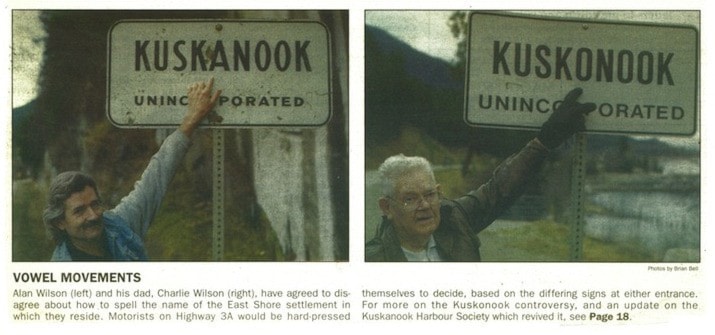One-hundred and eighth in a semi-alphabetical series on West Kootenay/Boundary place names
Last week we began looking at the origin of Kuskonook, formerly known as Kalama, Armstrong’s Landing, and Goat River Landing.
The current name was established on Jan. 26, 1898 when Kaslo and Slocan Railway president Daniel J. Munn and chief engineer John Hamilton Gray arrived to survey the townsite.
It was first mentioned in the British Columbia News of Feb. 4, 1898 under the headline “Kuskonook forever”: “The Kaslo and Slocan Land company last Wednesday decided to call the new town at the south end of the lake Kuskonook. It is an Indian name signifying ‘End of the lake.’”
Although embraced today for its uniqueness, at the time the Nelson Economist scoffed: “Kuskonook! And people will ask what’s in a name? On the ear of the aborigine it may sound well, but the cuss and the co and the nook will seem a curious combination to those not acquainted with the beauties of the native language or Chinook.”
Ads promoted Kuskonook as the planned terminus of the company’s Nelson and Bedlington Railway as well as the “only feasible townsite” for the CPR’s Crowsnest Railway, something their rival was hardly inclined to accept.
Kuskonook is also the name of a creek, although whether the creek gave the town its name or vice versa isn’t clear. However, the translation given by the townsite promoters appears accurate. The Ktunaxa dictionary gives ?a•q̓asak as “close, near, against the edge of something” and ?a•kuq̓nuk as “lake.”
(Porthill, Idaho, just across the border from Creston, was previously known as Ockonook — a post office opened under that name in 1893. Ockonook was said to mean “rocky point” in the Ktunaxa language. The online dictionary gives ʔa·kiў̕ǂaʔnuk as “large, flat rock” and ʔa·kuq̓ǂiǂnuk as “rock writing, painted rocks.”)
The spelling of Kuskonook versus Kuskanook has long been contentious, but the truth is it has always appeared both ways: Kuskanook turned up in the Nelson Miner only one day after Kuskonook’s earliest mention.
Still, Kusknook was the preferred spelling until 1906 when the CPR launched its new Kootenay Lake sternwheeler, the SS Kuskanook. Why would they name their ship after a rival company’s town? Was the alternate spelling deliberate? It’s hard to say, but in any case, it confused the issue.
The post office, which operated from 1898 to 1918, used Kuskonook, but most maps today show Kuskanook. Both spellings have their adherents.
The debate reached absurd heights when the Ministry of Highways’ northbound sign (probably installed in the 1960s) read “Kuskanook, Unincorporated” and a newer southbound sign read “Kuskonook, Unincorporated.” Maybe they were just hedging their bets? (The northbound sign has since disappeared.)
“It’s a serious controversy among Kuskonook residents of which there are seven permanent and a few temporary,” the late Alan Wilson told Brian Bell of the Creston Valley Advance in 1997.
Even Wilson and his father Charlie, who took turns as regional director for the area, were “totally opposed.” Charlie insisted on an O, maintaining that was the original spelling. But “most of us just don’t like it with the O. We like it with the A,” Alan said. “It’s been an A as long as anyone can remember.”
“A name is a name,” Charlie retorted. “Look at your tax notice. Everything is spelled with an O. I’ll haunt anybody that tries to change it.”
The Gazetteer of Canada and BC Geographic Names website both prefer Kuskonook, but the federal Fisheries and Ocean Dept. has Kuskanook on its sign at the harbour entrance, just beyond a Highway 3A pullout called the Kuskanook Rest Area. The Wilsons, however, lived on Kuskonook Road.
When the new Kuskanook marina opened, the Advance ran side-by-side photos of Alan and Charlie Wilson pointing to their preferred highway signs, with the headline “Vowel movements.”
Next: Kuskonook vs. Kuskanax
Previous installments in this series
Applegrove, Appleby, and Appledale revisited
Bakers, Birds, and Bosun Landing
Bannock City, Basin City, and Bear Lake City
Bealby Point (aka Florence Park) revisited
Boswell, Bosworth, Boulder Mill, and Broadwater
Brooklyn, Brouse, and Burnt Flat
Camborne, Cariboo City, and Carrolls Landing
Carmi, Cedar Point, Circle City, and Clark’s Camp
Carson, Carstens, and Cascade City
Christina City and Christian Valley
Cody and Champion Creek revisited
Champion Creek revisited, again
Columbia City, Columbia Gardens, and Columbia Park
Crawford Bay and Comaplix revisited
Dawson, Deadwood, and Deanshaven
English Cove and English Point
Forslund, Fosthall, and Fairview
Fort Shepherd vs. Fort Sheppard, Part 1
Fort Shepherd vs. Fort Sheppard, Part 2
Gladstone and Gerrard, revisited
Granite Siding and Granite City
Hall Siding and Healy’s Landing
Hudu Valley, Huntingtdon, and Healy’s Landing revisited
Inonoaklin Valley (aka Fire Valley)
Jersey, Johnsons Landing, and Jubilee Point
